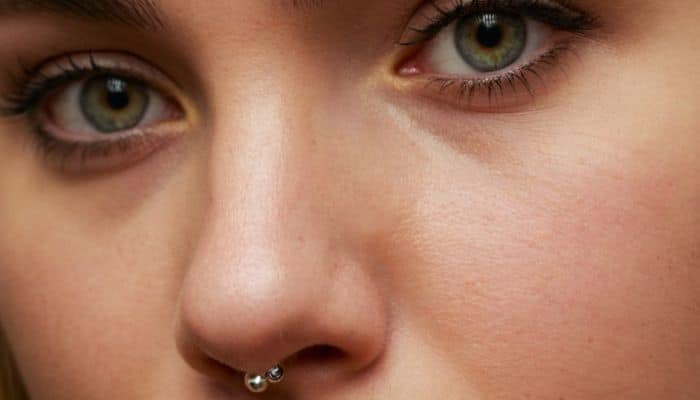Wearing a nose ring is a great way to showcase your style. This is why nose piercing is so much popular among girls and boys. While getting the piercing done by a professional is completely safe, still, preparing yourself the first time for the piercing is a bit of a task.
Before getting into nose piercing make sure to educate yourself about the risks and challenges. This will make things easier for you and you will exactly know what you are preparing for. For this, I have listed everything you need to know about the nose piercing.
Types Of Nose Piercing
Although the most common nose piercing around the world is nostril piercing, there other piercing locations that are worth exploring.
1. Septril Piercing
Septril piercing is one of the most complicated nose piercing which requires a lot of time and effort. In this process, a nose bone or curved barbell is inserted half-vertically on the bottom tip of the nose.
For this type of piercing, some nose structures are better than others. Usually, a wider septum area is preferable because there is more area to work with. If you are the one with this unique nose structure then you should definitely get it done to stand out in the crowd.
2. Septal Piercing
This is a piercing that goes through the nasal septum where there is a sweet spot called the “columella”—the area between the bottom of the nose and the cartilage.
This piercing should not go through the cartilage itself because that would be painful. A septum retainer or a hoop is the jewelry of choice for this type of piercing.
Septum piercing is a popular piercing, but it is not common. The reason behind this is that some people do not have columella, so their piercing can be done through the cartilage which can be extremely painful.
3. Nasallang Piercing
This type of nose piercing is a tri-nasal piercing that goes through both the nostril and the septum. It will look like you have two nostril piercings on either side of your nose, but the piercing uses just one straight barbell that goes straight across.
4. Bridge Piercing
In this type of piercing a straight barbell is placed on the bridge of the nose between the eyes. As the bridge piercing is only a surface piercing it will be highly prone to rejection. Unfortunately, the bridge of the nose cannot handle deeper insertions.
5. Rhino or Vertical Tip Piercing
A curved barbell is used for this one. Both ends of the barbell will be visible. One end will be visible on the tip of the nose, and the other end will show under the tip.
Nose Piercing Health Concerns

Although nose piercing has a smaller number of risks than that of other types of piercing like clit piercing, still there are risks involved. Make sure to avoid these risks as much as possible because an infected nose will not be attractive.
1. Infection
Staphylococcus bacteria is present in large numbers in the nasal cavity area. So in the case of any infection don’t take it lightly and get medical assistance as early as possible.
Signs of an infected nose piercing include persistent swelling, pus, aches or pain, and excessive bleeding. If you have a bump, this is a likely sign of infection.
Remember, a bump could be caused by an allergic reaction to jewelry or poor hygiene.
2. Perichondritis
This is an infection caused by the bacteria Pseudomonas aeruginosa in which the cartilage in your nose becomes inflamed, which can lead to tissue death.
3. Septal Hematoma
If you experience pain, swelling, and difficulty breathing, then you may have a septal hematoma. This occurs when blood collects between the nasal septum and the perichondrium.
4. Necrosis
An untreated infection could lead to necrosis, which is the death of tissue in the nasal wall. This could turn into a severe deformity, and the tissue would have to be removed.
Apart from the above conditions, you can have the rejection of metals in which wearing certain metals might cause your body to reject the jewelry. This could manifest with the body trying to push the metal out of your skin or, even worse, absorbing the metal into your skin.
Nose Piercing: Safe & Unsafe Metals To Wear
Be very careful while choosing a nose ring as it could have severe consequences on your health. Here is the list of safe and unsafe metals:
Safe Metals
1. Surgical Stainless Steel
Surgical steel is cheaper than most other alternatives and is a very common metal used for body jewelry. It is safe to use, but it is not 100% biocompatible like other options.
Most people can tolerate it just fine, but people with sensitive skin should choose titanium instead.
2. Titanium
This is one of the best options for people with sensitive skin. It not only looks great, but it is also the safest metal for all body jewelry.
3. Gold
Gold is beautiful, but it is easily rejected by the body. Some people may be able to pull off wearing it without any irritation once their piercing has healed.
Remember, gold should not be used on new piercings. Once the piercing has fully healed, choose 14k or 18k gold. Do not use gold-plated jewelry.
Also Read:
- 10 Best Sunscreen For Oily Skin That Actually Works
- How to Remove Lipstick Effectively? Proven Tips
- Difference Between French, Bikini And Brazilian Wax
Unsafe Metals
1. Silver
Sterling silver easily tarnishes and causes allergic reactions and bacterial growth. Thus avoid this metal is the best thing you can do.
2. Nickel
A lot of people develop a rash when their skin is exposed to nickel. So its better to avoid this metal.
Nose Piercing Aftercare
Here are certain points that are recommended by most experts,
- Wash the area several times a day, but not like the normal way you wash your face. Instead, fill up a little dixie cup with a saline solution (salt water), and then put your nose in the cup and maybe even blow some bubbles into it.
- Hold it in there for about 60 seconds.
- Do this several times a day to keep it nice and clean, and prevent it from getting infected.
Nose Piercing Healing Time
While the healing time varies from person to person, the common healing time for most of the piercings are as follows:
- Nostril Piercing: 4-6 months
- Septum Piercing: 6-8 weeks
- Nasallang Piercing: 4-6 months
- Rhino or Vertical Piercing: 6-9 months
- Bridge Piercing: 4-6 months
Nose Piercing Cost
The price of a typical nose piercing varies from $30 to $80. This is the total cost for the piercing and the jewelry.
If piercers charge separately, then the average cost of the piercing is $40 to $50 and the jewelry is around $10-$60, depending on the quality of the metal and the design.
Conclusion
While nose piercing is one of the easiest piercing processes still it requires specific aftercare to free from any infection. Additionally, to get things done more smoothly I will highly recommend visiting a professional rather than getting it done by any common piercer.




